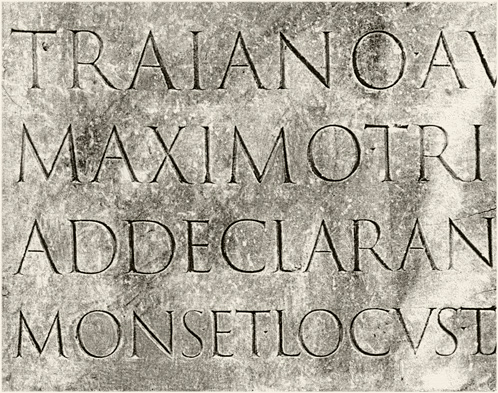

"And he set up in the Forum an enormous column, to serve at once as a monument to himself and as a memorial of his work in the Forum. For that entire section had been hilly and he had cut it down for a distance equal to the height of the column, thus making the Forum level."
Cassius Dio, Roman History (LXVIII.16.3)
With abbreviations expanded, the inscription at the base of the column reads,
SENATUS POPULUSQUE ROMANUS
IMPERATORI CAESARI DIVI NERVAE FILIO NERVAE
TRAIANO AUGUSTO GERMANICO DACICO PONTIFICI
MAXIMO TRIBUNICIA POTESTATE XVII IMPERATORI VI CONSULI VI PATRI PATRIAE
AD DECLARANDUM QUANTAE ALTITUDINIS
MONS ET LOCUS TAN<TIS OPE>RIBUS SIT EGESTUSWritten when Trajan held tribunican power for the seventeenth time, which was assumed on December 10, AD 112 and ended a year later, the column, itself, was dedicated in May AD 113, more than sixteen months after the forum, presumably just before Trajan's departure for Parthia. The last two lines of the inscription are problematic: "...to demonstrate how lofty a hill and [what area of] ground was carried away for these mighty works." The assumption is that the reference refers to the excavation of the Quirinal hill, which was cut back one-hundred Roman feet to provide level ground for the Markets of Trajan, a figure commemorated by the height of the column (columna centenaria), which matches that of the hill's face.

The lettering inscribed on the base of the column is termed scriptura monumentalis or capitalis monumentalis, a form of majuscular (capitals) used for larger architectural inscriptions. Like all capital letters in the Latin alphabet since the second century BC, it is shaded, the vertical strokes twice as thick as the horizontal ones. Here, too, the height of the letter is approximately eight and one-half to nine times the width of the vertical stroke, an ideal ratio for the letter type.
By studying the inscription on Trajan's Column, Father Edward Catich reconstructed how the Romans made their capital letter shapes. He hypothesized that the forms first were sketched using a flat square-tipped brush, using only three or four quick strokes to form each letter, the characteristic variations in line thickness formed by the changing cant of the brush. The letters then were cut in the stone by the same person (and not, Catich contended, separately by scribe and stone mason), the illusion of form being created by shadow.
This detail from the lower left corner of the inscription shows the letterforms in detail. Incised on a marble slab measuring four-and-a-half by ten feet, the lower edge is ten-and-a-half feet above the ground. This requires that the letters, themselves, vary in size, which they do by an inch, the first lines of the inscription, the ones farthest away from the viewer, being larger than those which are closer. Too, the same letter can vary in thickness and width to maintain the correct proportion between other letters. Such symmetry and balance convinced Catich that "the Trajan alphabet is the best roman letter designed in the Western world, and the one which most nearly approaches an alphabetic ideal." And, indeed, the inscription has served as the model for all subsequent Roman capital letterforms.
One example is "Trajan," a typeface developed by Carol Twombly for Adobe Systems. Modified for printing on paper, the font has stronger serifs than the original, with different stem and bowl weights, the letter "N" being narrower and "S" wider.
Depicted in low relief, the weapons and armor of the conquered Dacians are portrayed on the pedestal frieze in wonderful detail. On the cornice, swags of oak leaves tied with fluttering ribbons are held at the corners in the talons of eagles, two of which survive. Inside the square base, which was accessed by bronze doors, a vestibule leads to a landing and stairs on the right and, on the other side, behind another set of doors, to the sepulcher that held the ashes of Trajan in a golden urn (Aurelius Victor, De Caesaribus, XIII.11; Eutropius VIII.5) and later his wife, Plotina.
This restoration by Percier (1788) provides a better sense of the detail. 

Like an unrolled scroll, a spiral frieze winds twenty-three times around the column, depicting the campaigns of Trajan in Dacia in AD 101-102 and AD 105-106. It likely illustrates the emperor's own commentary on the wars, a book, now lost, that was housed in the adjacent library. Depicted in low relief, there are one hundred and fifty-five scenes, in which more than twenty-five hundred figures are represented, no less than sixty of Trajan, himself. Only eighteen scenes actually depict battles; most show the day-to-day activities of the army. Situated between the two libraries and enclosed by a peristyle, only the elaborately decorated base was not obstructed from view, and it is not certain if these scenes could be appreciated or even were ignored once the column had been erected.
At the top was a statue of the emperor in gilt bronze, access to which was by a spiral staircase illuminated by a series of slit windows cut into the marble.
References: The Origin of the Serif: Brush Writing & Roman Letters (1968) by Edward M. Catich; The Trajan Inscription (1973) by Edward M. Catich; Eutropius: Historiae Romanae Breviarium (1876) translated by Rev. John Selby Watson; Roma Antiqua: Forum, Colisée, Palatin (1985).